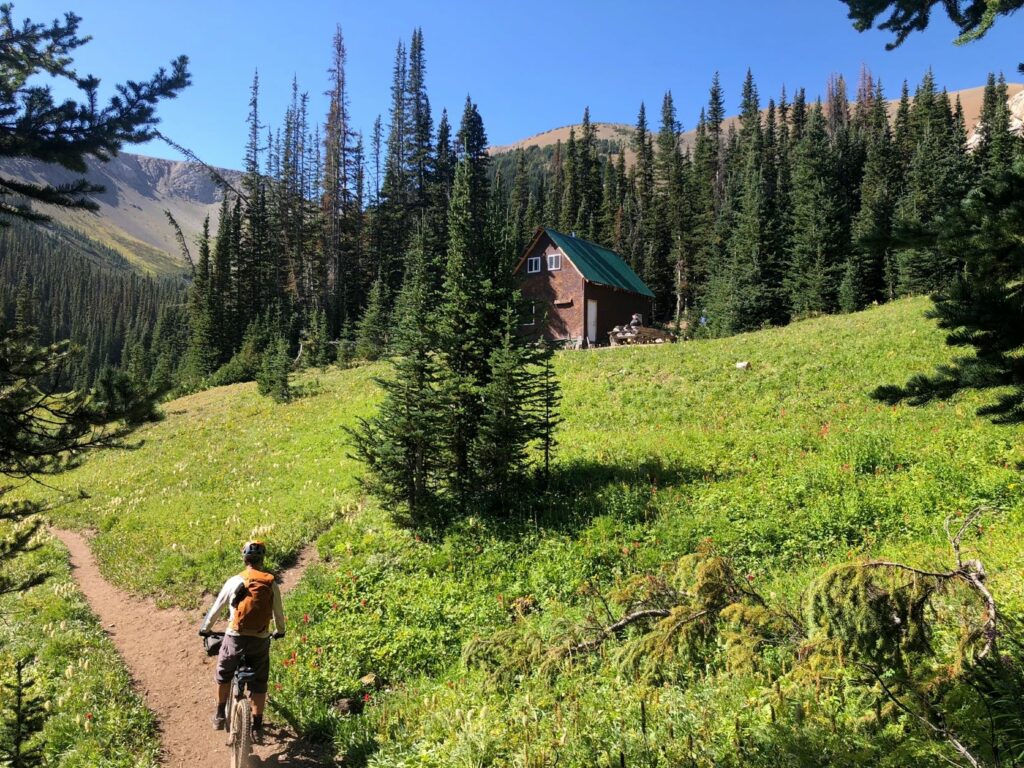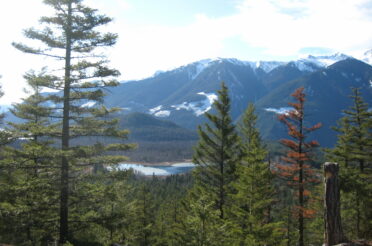Hut-to-Hut Mountain Bike Tour through the South Chilcotin Mountains

Our hut-to-hut mountain bike trip through the South Chilcotin Mountains was a true nature connection. We traveld light on our hut-to-hut mountain bike trip.
During our hut-to-hut Mountain Bike trip, we got to explore the Soutch Chilcotin Mountains. Located within the Chilcotin Ark, the South Chilcotin Mountains have some of the most wild and rugged terrain you can explore on a hut-to-hut mountain bike tour. Nine months a year the mountain passes are covered in metres of snow, only July, August and September allow access to this hidden treasure and untamed wilderness.
During our mountain bike hut-to-hut trip through the South Chilcotin Mountains, we experienced nature connection by immersing ourselves into this wilderness as we rode our mountain bikes through the colourful alpine meadows and smelled the different flowers. We rode through the valley forests and had to push your mountain bikes up to the steep mountain passes, where we could enjoy the sun on your face. We drunk pure mountain water from the little creeks and picked wild strawberries and blueberries along the way. We also had the opportunity to view wildlife in their natural habitat, from grizzly bears to mountain goats. A hut-to-hut mountain bike trip through the South Chilcotin Mountains just facilitates a whole different level of nature connection. Because we experienced this level of nature connection, we made sure to not impose ourselves on nature. Instead we want to be part of this unique place, respect it and look after it.
So when looking at the options on how to access the South Chilcotin Mountains without leaving a negative impact on nature and the wildlife, we came across the 7 day Hut-to-hut back country mountain bike circuit. This self-guided hut-to-hut mountain bike tour is the perfect opportunity for a true nature connection and an environmentally sustainable alternative to accessing the back country by helicopter or float plane.
We were able to explore the South Chilcotin Mountains under our own power while we were riding our mountain bikes from hut-to-hut through the Relay, Big Creek, Upper Tyaughton and past Trigger, Lorna, Hummingbird and Spruce Lake and Eldorado areas. Every night we stayed in a rustic, fully stocked satellite research huts. They provide the most important things such as a cabin and wall tents to sleep in, the cooking facilities, and a sleeping pad. Being able to travel from hut-to-hut on our mountain bike trip allowed us to pack light. Overall, we found that travelling light, a bit of clothes, our fresh food and a sleeping bag was very manageable. As we were riding through Grizzly bear country, we also did not have to worry about where to hang up our food and could enjoy the safety of the cabins over night.
However, what was truly amazing on our mountain bike trip, was the way we got empowered to look after the South Chilcotin Mountains, an ecologically important place. We learned about conservation and stewardship projects in the Chilcotin Ark. So before our hut-to-hut mountain bike trip started, we were educated on the area, its history, flora and fauna as well as ongoing conservation projects and how they relate to the bigger picture of protecting this ecologically important place. Next, we were provided with their current research tools and information on how to use them during our hut-to-hut mountain bike trip.
The connection with nature on a mountain bike is different than on foot. It is faster and the immediate things around you are more intense: The roots and stones on the trail, the smells, the next turn, the possibility of a grizzly bear encounter after that turn. We had to push our mountain bikes up the steep mountain passes of Relay, Lorna, Deer, Windy and Camel Pass which we could ride down after. But we made sure to not go to fast as nothing surprises a grizzly bear or other wildlife more than a speeding mountain bike. We would pause along the way to get immersed into the wilderness by taking the time to appreciate the colours of the soils, the wind blowing a cool breeze, the quietness and peace of the untouched wilderness. We would scout for wildlife and learn about the plants along the trail. It is important to stay on the trail to protect the wild flowers and vegetation in the alpine.
Every night at camp we would fill in the forms about where we saw wildlife and how it behaved or what kind of plants we saw and collected grizzly bear hair from trees for DNA analysis. When we returned for our last night, we reviewed all the information and data we collected throughout our hut-to-hut mountain bike trip. The data we collected is used to gain a better understanding of population numbers and habitat changes and provides the basis for implementing conservation projects in the South Chilcotin Mountains. So during our mountain bike trip, we were able to participate in hands-on conservation projects and contribute to the protection of this ecologically important place.
Our mountain bike trip ended with wonderful experiences, impressions, good feelings and memories we will always look back on. We do hut-to-hut mountain bike trips like this every year, and this was the best one overall. Accessing the back country of the South Chilcotin Mountains under our own power might have been challenging, but it was more rewarding than any other way. Not only was it a great opportunity for myself to experience what I was capable of. As a group it was also a great bonding experience as it brought us closer and everyone was involved in making this mountain bike trip a success.
However, most importantly, we felt connected to nature and appreciative for it. We developed a better understanding of how our actions can affect and impact the wilderness and were empowered to take responsibility for it. As the untouched wilderness of the Chilcotin Ark facilitated our adventures, we were able to reciprocate by looking after it and by participating in on-going conservation projects that will do so long into the future.
By Marc B.
More information here


